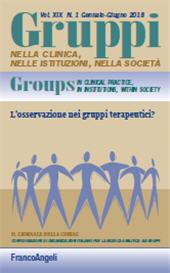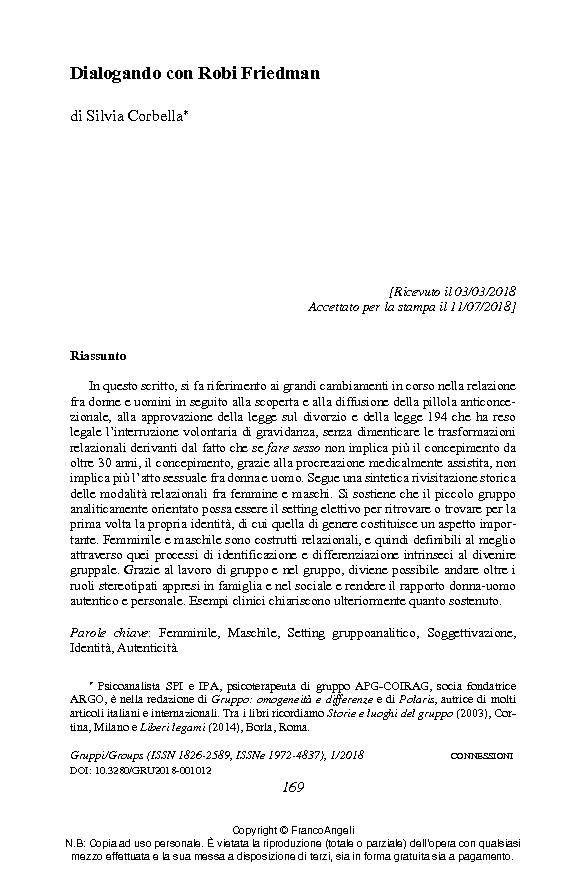2018 - Franco Angeli
Article
Digital Version
Télécharger | Copier/coller | Impression
Dialogando con Robi Friedman
169-174 p.
- In questo scritto, si fa riferimento ai grandi cambiamenti in corso nella relazione fra donne e uomini in seguito alla scoperta e alla diffusione della pillola anti-concezionale, alla approvazione della legge sul divorzio e della legge 194 che ha reso legale l'interruzione volontaria di gravidanza, senza dimenticare le trasformazioni relazionali derivanti dal fatto che se fare sesso non implica più il concepimento da oltre 30 anni, il concepimento, grazie alla procreazione medicalmente assistita, non implica più l'atto sessuale fra donna e uomo. Segue una sintetica rivisitazione storica delle modalità relazionali fra femmine e maschi. Si sostiene che il piccolo gruppo analiticamente orientato possa essere il setting elettivo per ritrovare o trovare per la prima volta la propria identità, di cui quella di genere costituisce un aspetto importante.
- Femminile e maschile sono costrutti relazionali, e quindi definibili al meglio attraverso quei processi di identificazione e differenziazione intrinseci al divenire gruppale. Grazie al lavoro di gruppo e nel gruppo, diviene possibile andare oltre i ruoli stereotipati appresi in famiglia e nel sociale e rendere il rapporto donna-uomo autentico e personale. Esempi clinici chiariscono ulteriormente quanto sostenuto. [Testo dell'editore].
- In this paper, reference is made to theongoing, great changes in the relationships between women and men following to the invention and widespread use of the contraceptive pill, the approval of the law legalizing divorce and the Italian Law 194, which has made voluntary termination of pregnancy legal. Relational changes also derive from the fact that, for the past thirty years, having sexhas not implied conception anymore; at the same time, thanks to medically assisted procreation, conceptionhas become possible without implying a sexual act between a man and a woman. A brief historical review of the relational patterns between women and men follows. The author maintains that the small, analytically-oriented group can be the most suitable setting where to rediscoverone's own identity - gender identity being an important part of it - or else, where to findit for the very first time.
- Feminine and masculine are relational constructs which can, therefore, be best defined through those identification and differentiation processes that are typical of group work. Working with the group and in the group makes it possible to overcome stereotypicalroles shaped by family and society and to attain authenticity in the woman-man relationship. Clinical situations are included to exemplify the author's assertions. [Publisher's text].
-
Informations
Code DOI : 10.3280/GRU2018-001012
ISSN: 1972-4837
KEYWORDS
- Femminile, Maschile, Setting gruppoanalitico, Soggettivazione, Identità, Autenticità
- Feminine, Masculine, Group-analytic setting, Subjectivation, Identity, Authenticity
-
Dans le même fichier
- Presentazione del numero
- Ex-OPG vs REMS, rivoluzione democratica e sfida terapeutica
- Esplorare un costrutto semantico inafferrabile : la famiglia
- L'osservazione istituzionale
- L'osservazione nella psicoterapia di gruppo con adolescenti : una prospettiva intersoggettiva
- I gruppi psicodinamici brevi e a termine nella cura dell'addiction : un'esperienza clinica in un SerD Veneto
- Edifici fascisti e rappresentazione della violenza : regressione ed elaborazione psichica nell'individuo, nel gruppo e nella civiltà
- Ciò che unisce e divide i generi sessuali : dialogo in gruppi
- Il lavoro di cura con gli adolescenti : intervista a Tito Baldini
- Nuovo anno accademico : la mossa di apertura della Scuola COIRAG : i report dei seminari delle sedi di Milano, Roma e Padova
- Il progetto SPRISTAD : uno studio longitudinale sullo sviluppo professionale degli specializzandi in psicoterapia
- Dialogando con Robi Friedman
- Maschile e Femminile tra ruoli sociali e funzioni psichiche : connessioni dal Dreamtelling con Robi Friedman
- Rêverie e trasformazioni tra madre e bambino
- Recensioni



